ECON10004
1/183
There's no tags or description
Looks like no tags are added yet.
Name | Mastery | Learn | Test | Matching | Spaced |
|---|
No study sessions yet.
184 Terms
What are the 10 principles of economics?
1. People face trade-offs
2. The cost of something is what you give up to get it
3. Rational people think at the margin
4. People respond to incentives
5. Trade can make everyone better off
6. Markets are usually a good way to organize economic activity
7. Governments can sometimes improve market outcomes
8. A country's standard of living depends on its ability to produce goods and services
9. Prices rise when the government prints too much money
10. Society faces a short-run trade-off between inflation and unemployment
net profit benefit
= total benefits (TB)- TC
absolute vs comparitive advantage
absolute advantage is the ability to produce a good using fewer inputs than another producer
comparative advantage: is the ability to produce a good at a lower opportunity cost than another producer
sunk costs
reflect the value of resources that were already used before making a decision about which action to take
rational decision makers think at the margin
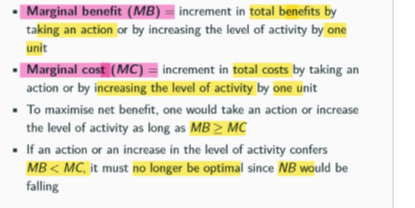
substitutes vs compliments
S: the price of one good is positively related to the deman of the other good
C: inversly related
elasticity of demand demand
when there is change in P, there is a little change in quantity (inc p= dec in q)= insensitive to change
Price inc= total revenue inc (vice versa)
Eleastic demand= sensitive to change.
Price inc= TR dec
Unit elastic demand: equal change. Inc in p by 20% and dec in q by 20% = 1 (p%/Q%)
Perfect inelastic: inc/dec in price= no change to quantity= 0 (vertical line)
Perfect elastic (horizontal line)
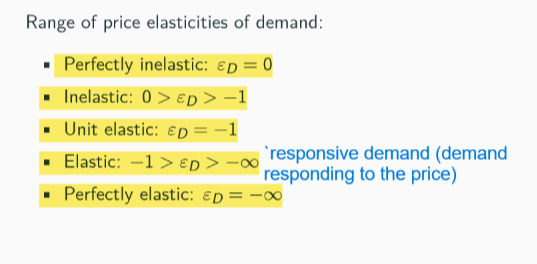
elasticity formula

price elasticity of supply
measures the responsiveness of quantity supplied to a change in price
elastic=sensative
inelastic= insensitive
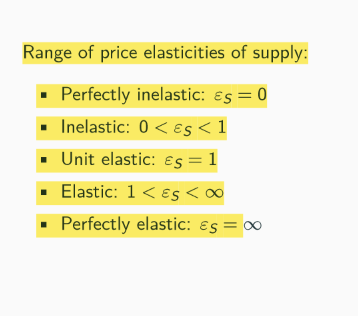
effects on equilibrium
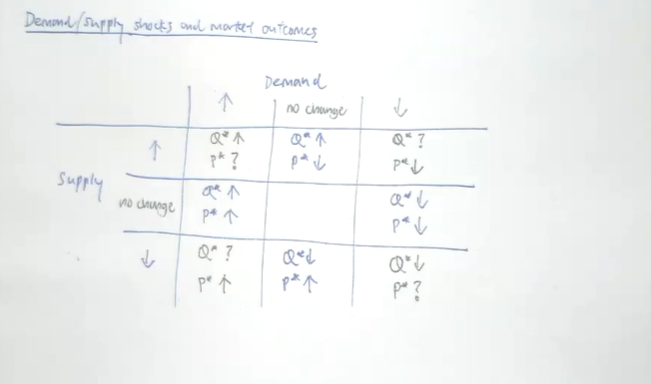
subsidy on consumer
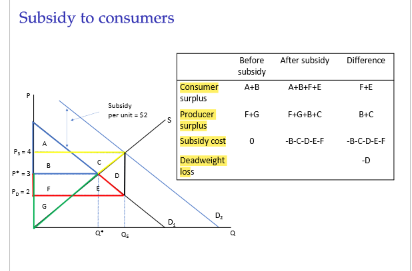
tax/subsidy application
tax revenue= T times Qtax
DWL= 1/2x Tx (Qno tax-Qtax)
gov spending=SxQsubsidy
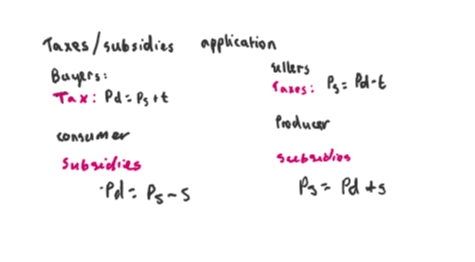
elasticity for tax and subsidy
For a Tax:
If demand is more inelastic than supply → Consumers bear more of the tax.
If supply is more inelastic than demand → Producers bear more of the tax.
🔹 For a Subsidy:
If demand is more inelastic than supply → Consumers get more of the subsidy benefit (lower prices).
If supply is more inelastic than demand → Producers get more of the subsidy benefit (higher revenues)
subsidy to producers
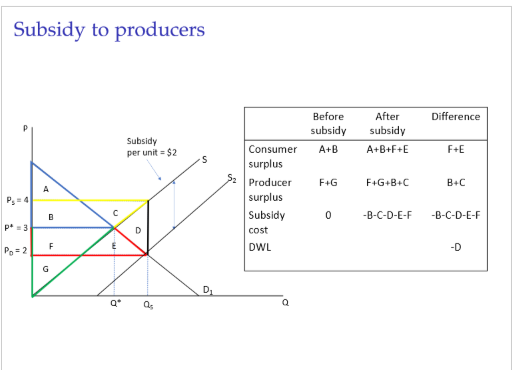
quota
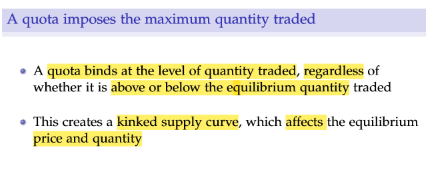
types of externalities
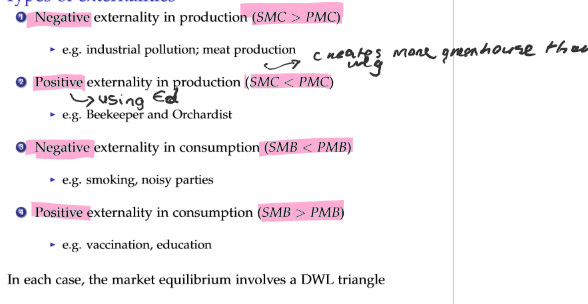
government interventions

pigouvian subsidy on positive externalities
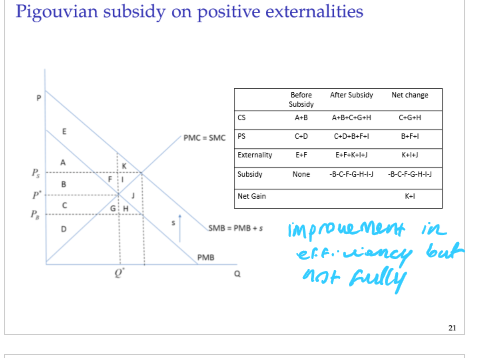
positive externalities in production
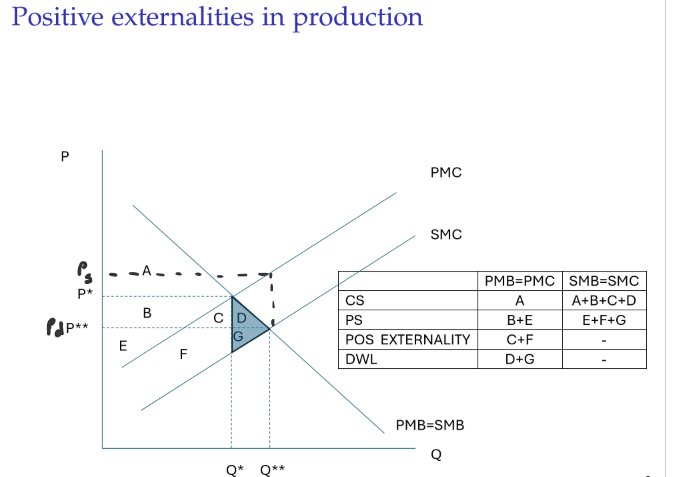
negative externalities in consumption
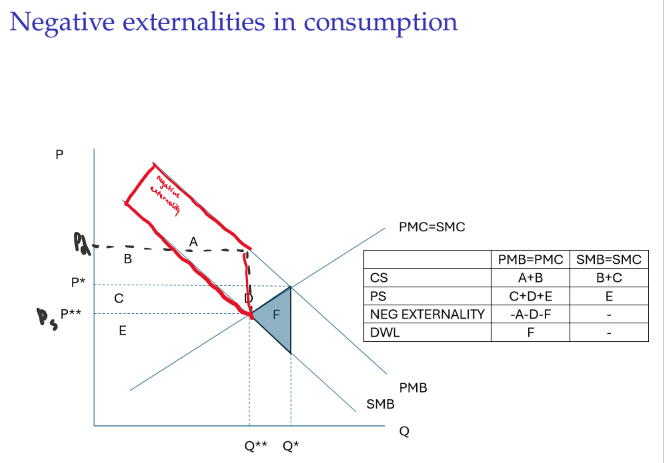
coasian bargaining
sees bargaining as the most efficient solution to resolving negative externalities => creating a market-like solution
why are public goods under-supplied in a competative market
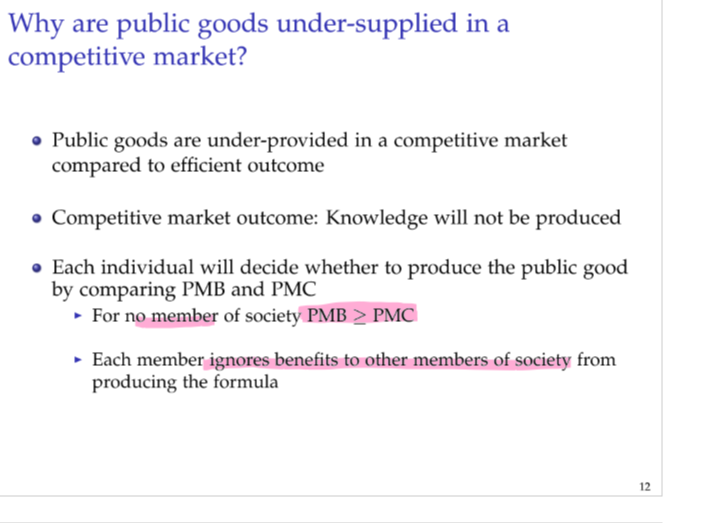
moral hazard
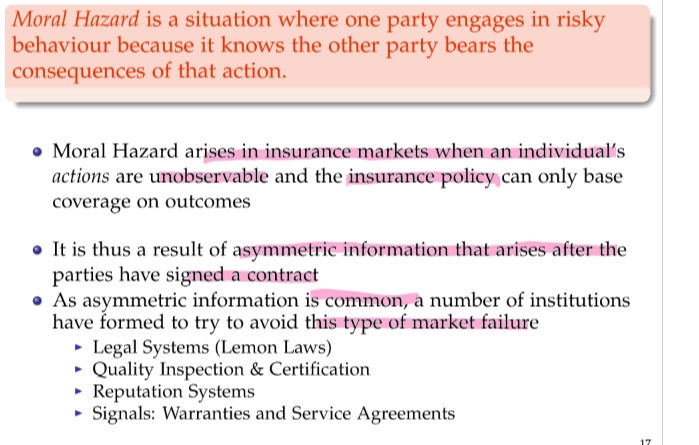
total product & marginal product

law of deminishing returns
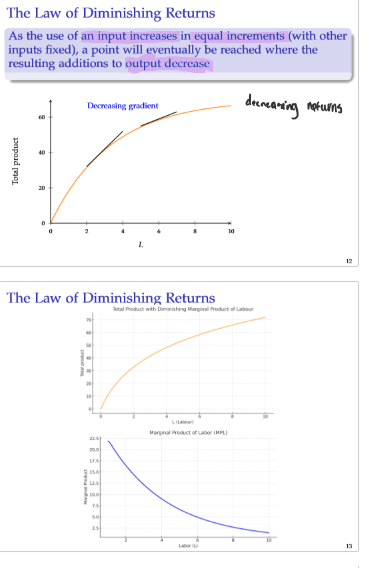
costs
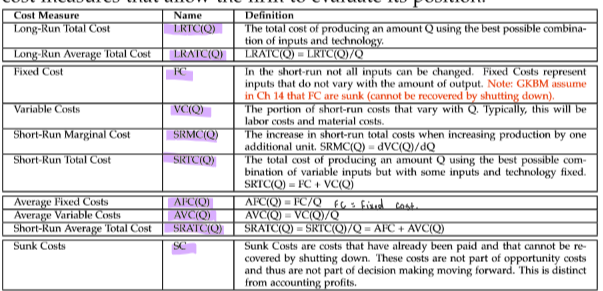
are fixed cost and sunk costs the same
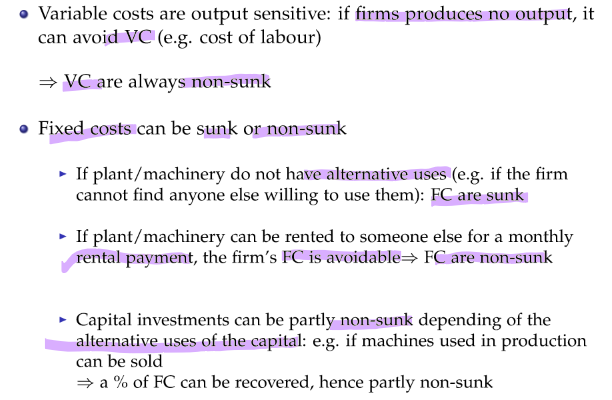
cost curves in the short run

short run and long run ATC
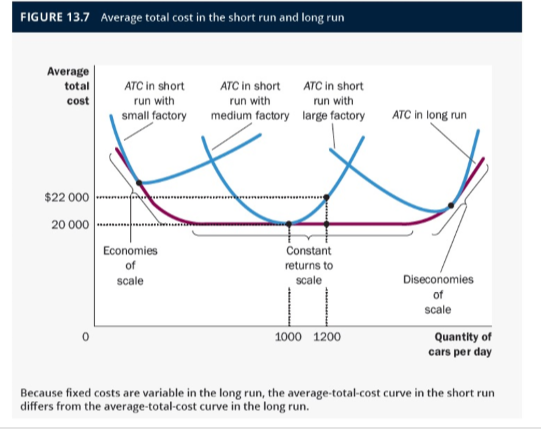
economies and diseconomies of scale
return to scale= % change output Q/% change input Q
economies of scale= the output range over which long-run ATC are falling
diseconomies of scale describes the ouput range over which long-run ATC are rising

a perfectly competitive market has three key features
price taking: Each firm accounts for a small share of the market output and its decisions have no impact on the market price
product homogeneity: all products are perfectly substitutable
free entry and exit
pure monopoly
is a market that has only one seller but many buyers
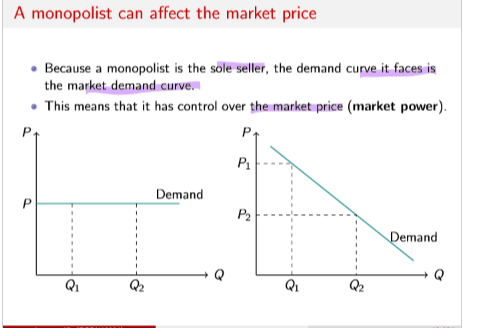
monopolists production problem
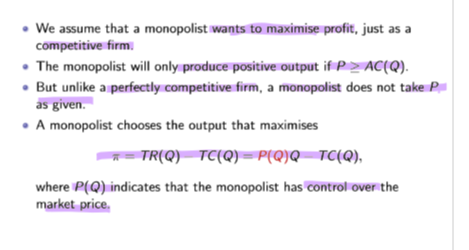
monopoly vs perfect competition
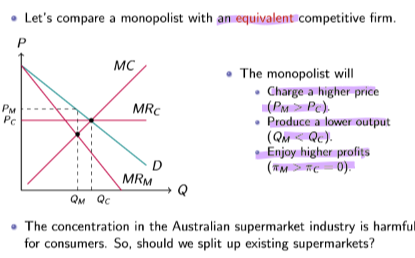
long-run exit price
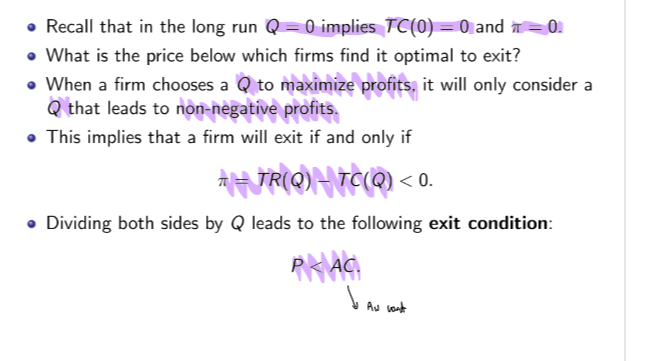
marginal revenue and average revenue

What is the production possibilities frontier?
A graph the shows the various combinations of output that an economy could produce given the available factors of production and the available technology.
What is opportunity cost?
The loss of potential gain from other alternatives when one alternative is chosen.
What is comparative advantage?
The ability to produce a good or service at a lower opportunity cost than other producers.
How should a price be set in trade?
It should lie between the two opportunity costs of the supplier and consumer.
What Assumptions are made in a Perfectly Competative Market?
1. All goods are exactly the same
2. Buyers and Sellers are numerous hence no individuals can have an impact.
What causes a shift in the demand curve?
Income
Prices of substitutes and complements
Taste
Expectations
Number of Buyers
Whats an inferior good?
When an increase in income leads to a decrease in demand. Suggesting a lower IED.
What is a normal good?
Increase in income leads to an increase in demand and elasticity.
What is a substitute good?
Two goods for which a decrease in price of a good leads to a decrease in demand for another.
What is a complementry good?
Two goods for which a decrease in the price of one good leads to an increase in demand for another.
What is the Law of Demand?
The claim, other than things being equal, the quantity demanded of the good falls when the price rises.
What is the Law of Supply?
The claim, other than things being equal, the quantity supplied of a good rises when the price of a good rises.
What shifts the supply curve?
Input prices
Technology
Expectations
Number of Sellers
What happens when input prices rise?
When costs rise and the product becomes less profitable, decreasing quantity supplied.
When is there a surplus?
When the Quantity Supplied is greater than Quantity Demanded. Suppliers can respond by cutting prices to increase demand.
When is there a shortage?
When the Quantity Demanded is greater than Quantity Supplied. Suppliers can increase price to decrease demand toward shortage.
What is Price Elasticity of Demand?
A measure in how much quantity is demanded of a good response to a change in the price of that good. Calculated by the percentage change in price quantity demanded divided by the percentage change in price.
Determinants of PED?
Availability of close substitutes
Necessities vs Luxuries
Definition of the specific market
Time Horizon
How is revenue affected depending of PED?
Inelastic demand causes an increase in revenue when their is an increase in price.
Elastic demand causes a decrease in revenue when price increases.
What is the Income Elasticity of Demand?
A measure of how much the quantity demanded of a good responds to a change in consumers income. Calculated as percentage change in quantity demanded divided by the percentage change in income.

What is the Cross Price Elasticity of Demand?
A measure of how the quantity demanded of a good responds to a change in price of another good. Calculated as Percentage change in quantity demanded of good 1 divided by the percentage change in the price of good 2.

What is the Price Elasticity of Supply?
A measure of how much the quantity supplied of a good responds to a change in price of that good. Calculated as the percentage change in quantity supplied divided by the percentage change in price.
Determinates of PES?
Flexibility of production.
Time period.
What is Consumer Surplus?
Willingness to pay less the actual amount paid, influencing the quantity demanded. Represented by the area below the demand curve. Is a measure of wellbeing from the consumer's view.
How does a lower price rise Consumer Surplus?
The initial consuer surplus will increase, and new consumer surplus will be created as the equalibrium moves along the supply curve as theyre is a lower willingness to pay.
What is Producer Surplus?
The amount a seller is paid for a good minus the sellers cost, influencing the quantity supplied. Represented by the area above the graph.
What is Total Surplus?
The sum of consumer surplus and producer surplus to measure toal economic wellbeing (welfare) and when maximised is considered a effecient market. Calculated by Value to Buyers less Cost of Sellers.
How can Total Suprlus be inefficient?
When a high cost producer is used, opposed to low cost; Or their are consumers who value the good more are not consuming .
How is Market Equalibrium Efficient?
Free Markets allocate supply of goods to the buyers who value most highly. Simirally, allocate demand for sellers who can produce at a lower cost. Hence, producing the quantity of goods that maximise total surplus.
Define Price Ceiling
a legal maximum on which a good can be sold. It can create a market shortage if below the equilibrium price., which can grow in the long run.
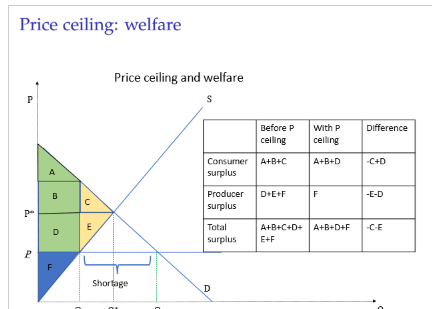
Define Price Floors
A legal minimum on the price at which a price can be sold if above equilibrium can create an excess surplus. supports workers
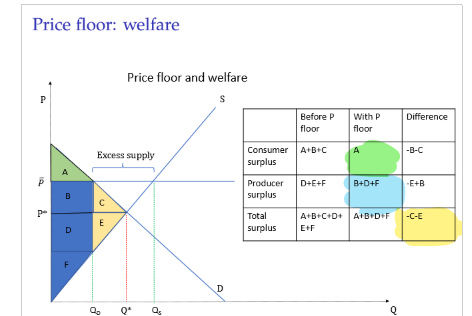
What is a tax on the supplier?
The supplier receives less than the price, hence they will look for the quantity at which the distance between supply and demand equals the tax. This discourages market activity, as both parties incur the tax.

What is a tax on the consumer?
When buyers pay the tax, the price buyers pay is higher than sellers by the amount of tax.
What happens to tax when there is elastic supply and inelastic demand?
the incidence of tax falls more heavily on consumers
What happens to tax when there is inelastic supply and elastic demand?
The incidence of tax falls more heavily on producers.
How do subsidies affect market outcome?
decrease prices for the consumer and increase priec received by the producer
funded by taxes
Define Dead Weight Loss?
the surplus that is lost because tax discourages those mutually advantageous trades.
What are the determinants of DWL
size of loss refers to greater on change in quantity demanded/ supplied.
The greater the elasticities of supply and demand, greater DWL is.
What is the laffer curve?
shows the relationship between the size of tax and government revenue.
What is the market status of a exporting company?
equilibrium is at the world price, which suggests producers are better off compared to selling to domestic markets, making consumers worse off. The trade raises economic wellbeing, as gains exceed losses.
Define Tarrifs?
A tax on goods produced abroad and sold domestically, reducing domestic quantity demanded and increasing domestic quantity supplied. This moves the domestic market closer to equilibrium.
What is the DWL for Tarrifs?
Left is from overproduction and right is from underproduction.
What are the other benifits from trade?
Increased variety of goods
lower cost through economies of scale
increased market competition
increased productivity
enhanced flow of ideas
What are the arguments for restricting trade?
destroys domestic jobs whilst growing other economies
can threaten national security as dependence on other countries is formed.
infant industries'
unfair competition
protection as bargaining
Define negative externality
the harm, cost, or inconvenience suffered by a third party because of actions by others
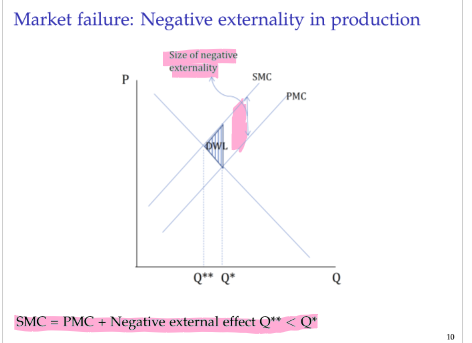
Define Positive Externality
the social value of the good is above the demand curve, to which the private curve shall meet.
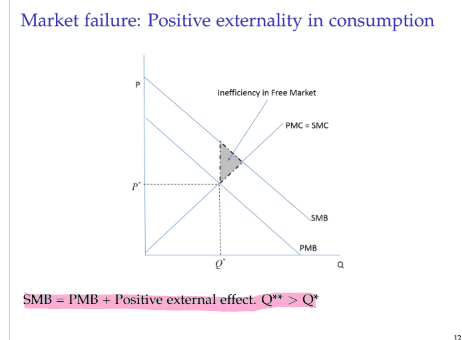
Define Corrective Tax and Subsidies
taxes aim to resolve negative externalities whereas subsidies solve positive externalities. The tax are more efficient, as the producer can equally meet the regulation, however it can encourage tax evasion.
Define tradeable Permits (Externalities)
permits may be paid for to pass regulation; usually when allocation is efficient and requires the company to pay, internalising the externality
What are the private solutions to externalities?
charities
private sponserhips
contracts
What is the Coase Theorem?
Private economic actors can potentially solve the externalities themselves. Whatever the initial distribution is, the interested party can reach a bargain in which everyone is better off.
Why private solutions to externalities do not always work?
bargaining doesn't always work
transaction costs.
What are the classification factors for goods?
excludability, where someone can be stopped from using it.
rivalry, where a persons use decreases someone elses use.
Define Private Goods?
Goods are both rival and excludable (ice cream)
Define Public Goods
neither excludable nor rival, street lighting
Define Common Resource?
goods are rival in consumption but not excludable (fish)
Define Club Goods
excludable but not rival (netflix)
What is the free-rider problem?
People receive benefits for a good without paying for it. In a private market, free riders create an externality and prevent the market from supplying certain goods.
Define Market Failure
inefficient outcomes: externalities, public goods, asymmetric information and imperfect consumption.
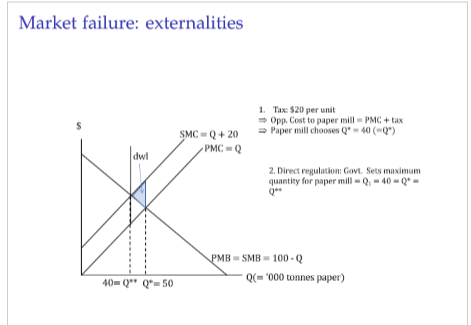
Define Pigouvian tax
When SMC = PMC + Tax. Used on negative externalities in production. DWL is a good effect as there is less wastage, and gain on the welfare of the original room for efficiency.
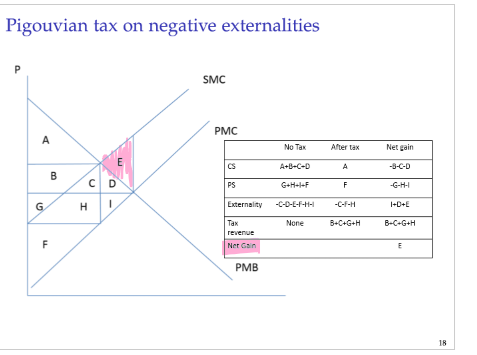
Define implicit and explicit costs.
Implicit does not require an outlay of money from the firm, whereas explicit does.
Define the short run?
A period of time in which atleast one costing factor is fixed.
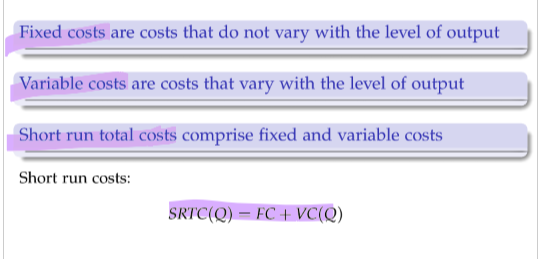
Define the long run?
The period of time needed for all factors of production become variable
Define diminishing Marginal Product?
Marginal Product of an input declines as quantity increases.
Define Rising Marginal Costs
Reflects the property of diminishing marginal product. All assets may not be utilized, and initially will provide a higher product for a lower marginal cost.